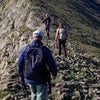Utah, Glen Canyon
Receding water levels mean more miles of choice desert hiking and kayaking.
Plummeting lake levels infuriate motorboaters and fishermen, but look who’s cheering: kayakers and hikers who enjoy solitude, deserted islands, and pristine beaches. Thanks to 4 years of drought, parts of Glen Canyon that have been covered since 1980 are emerging. As of February 2003, the lake was down 85 feet, the lowest it’s been since the canyon was dammed.
One result is that some tributary canyons are drying out. The alcoves of Music Temple and Davis Gulch, where wandering artist Everett Ruess disappeared in 1934, have several more miles of hiking available. The best stretch for camping is along the remote Escalante Arm, which you can also reach by hiking down tributary canyons off lower Hole-in-the-Rock Road, south of the town of Escalante. Another result of lower water is the appearance of new islands and beaches where paddlers can set up basecamps for a week of fishing, swimming, and exploring.
Contact: Glen Canyon National Recreation Area, (928) 608-6200; www.nps.gov/glca/index.htm; Carl Hayden Visitor Center, (928) 608-6404
